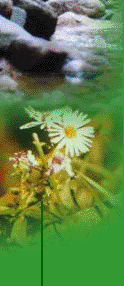Water surface zone
Many
plants and animals have special adaptations for survival in this zone, for example many insects can walk on water. Other animals,
especially flying insects, can become accidentally trapped on the surface and become food for pond animals.
Many
animals need to go to the surface, or live just below it, to get their supplies of oxygen.
Water plant zone
In
a shallow pond, this zone may include the whole pond, in larger lakes it may only cover the area nearer the banks. This zone
contains all the rooted plants from Rushes to Elodea. Along with these plants are many animals, some which use the plants
for food, others use them for shelter or protection.
Open Water Zone
In a
larger pond or lake there are usually areas where there are no rooted plants. This is because light will reach the deeper
water. This zone will have plankton near the surface and many animals feeding in it.
Mud zone
The bottom
of a pond may be made up of mud (fine particles of soil or sand and organic materials. Although it may appear as if there
is little alive in the mud, this region is where the scavengers and decomposers will be found along with their predators.
Typical organisms found around the mud include tadpoles, worms, yabbies, mussels, snails, fungi and microscopic organisms,
especially bacteria.
Some
organisms are found buried in the mud, others live on top of it. Many filter feeders are found in this zone, they filter the
detritus from the water or from the mud.
Detritus:
Fine particles made up of the wastes or dead remains of plants and animals. These particles will sink to the bottom and become
food for many decomposers.




